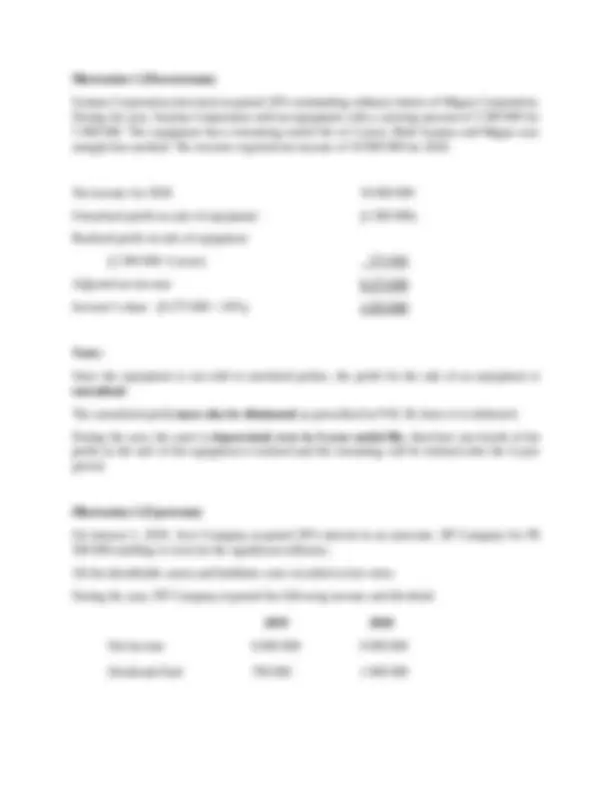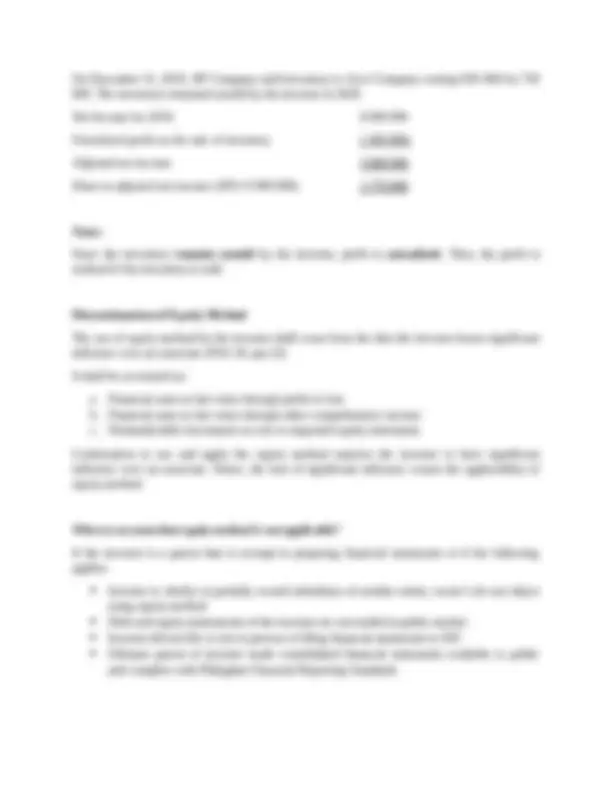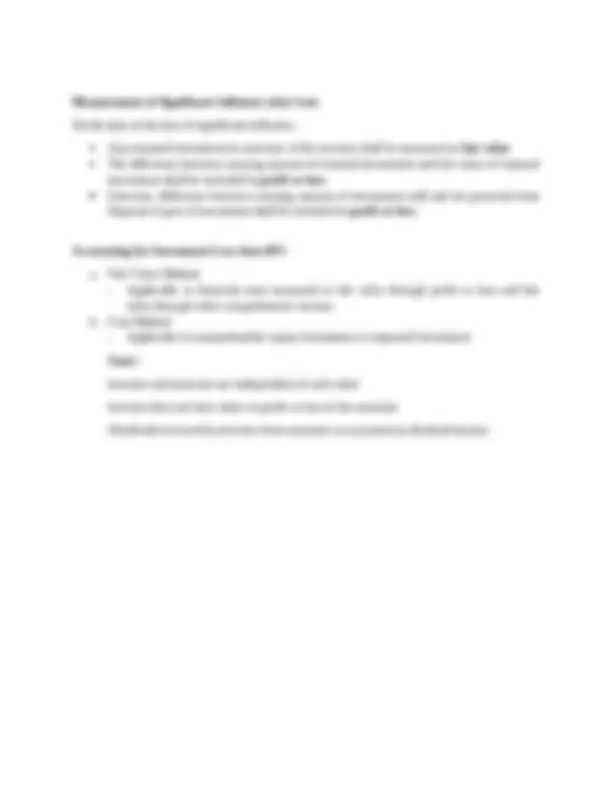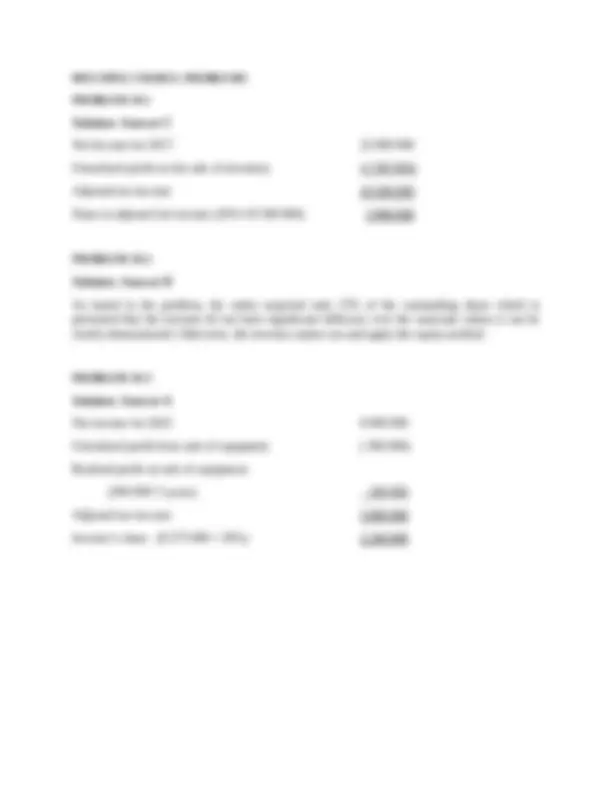






Study with the several resources on Docsity

Earn points by helping other students or get them with a premium plan


Prepare for your exams
Study with the several resources on Docsity

Earn points to download
Earn points by helping other students or get them with a premium plan
Community
Ask the community for help and clear up your study doubts
Discover the best universities in your country according to Docsity users
Free resources
Download our free guides on studying techniques, anxiety management strategies, and thesis advice from Docsity tutors
This is a lecture note regarding concept of Financial asset at amortized cost. This can be used as a reading and material in understanding Financial accounting and reporting.
Typology: Lecture notes
1 / 8

This page cannot be seen from the preview
Don't miss anything!





Definition of Associate An entity, where an investor obtains a significant power or influence over it. What is a significant influence? As defined in PAS 28, it is the power to participate in financial and operating policy but it does not mean to have the control over those policies. Determination of Significant Influence Percentage of Investment Presumption Type of Investment Less than 20% Investor does not have significant influence over the investee’s entity Financial assets at fair value 20% to 50% Investor have significant influence over the investee’s entity Investment in Associate More than 51% Investor has the control over the investee’s entity Investment in Subsidiary INTERCOMPANY TRANSACTIONS ASSOCIATE ASSOCIATE
Upstream Transactions Transaction that occurs when an investee (associate) sells assets to the investor Downstream transactions Transaction that occurs when the investor sells assets to an investee (associate) Adjustment of Investee’s Operation a. Most recent financial statement of the associate is used by investor in applying equity method The associate shall prepare for the use of the financial statement considering the same date as the financial statement of the investor only if the reporting period between investor and investee differs. The difference between the reporting dates shall not be more than three months. b. Adjustment are made when there are difference in accounting policies , investor shall conform with the accounting policies of the associate c. Gains and losses resulting from the upstream and downstream transactions between an investor and associate are recognized in the entity’s financial statements only to the extent of unrelated investor’s interests in the associate. Accounting Issue Elimination of unrealized profit in downstream transactions PAS 28, does not provide clear explanation with regards to the accounting issue Computation of investor’s shares are believed to be the same whether upstream or downstream Point: In determining investor’s share, unrealized profit must be eliminated.
On December 31, 2019, HP Company sold inventory to Acer Company costing 650 000 for 750
Measurement of Significant Influence after Loss On the date of the loss of significant influence; Any retained investment in associate of the investor shall be measured at fair value The difference between carrying amount of retained investment and fair value of retained investment shall be included in profit or loss Likewise, difference between carrying amount of investment sold and net proceeds from disposal of part of investment shall be included in profit or loss Accounting for Investment Less than 20% a. Fair Value Method
PROBLEM 18- On January 1, 2022, Mimi Company acquired 40% outstanding shares of Viy Company for P4 500 000. The fair value and carrying amount of the identifiable assets are equal. The investor sold equipment costing P200 000 to associate for P500 000 with a remaining useful life of 3 years. Viy Company reported P6 000 000 net income and P1 000 000 cash dividends paid. What is the investor’s share in the profit of associate for 2022? A. 2 120 000 B. 2 000 000 C. 2 240 000 D. 1 800 000 ANSWER KEY (CHAPTER 18)
MULTIPLE CHOICE: PROBLEMS PROBLEM 18- Solution: Answer C Net Income for 2017: 22 000 000 Unrealized profit on the sale of inventory (2 500 000) Adjusted net income 19 500 000 Share in adjusted net income (20%×19 500 000) 3 900 000 PROBLEM 18- Solution: Answer D As stated in the problem, the entity acquired only 15% of the outstanding share which is presumed that the investor do not have significant influence over the associate unless it can be clearly demonstrated. Otherwise, the investor cannot use and apply the equity method. PROBLEM 18- Solution: Answer A Net income for 2022 6 000 000 Unrealized profit from sale of equipment ( 300 000) Realized profit on sale of equipment (300 000/ 3 years) 100 000 Adjusted net income 5 600 000 Investor’s share (8 275 000 × 20%) 2 240 000